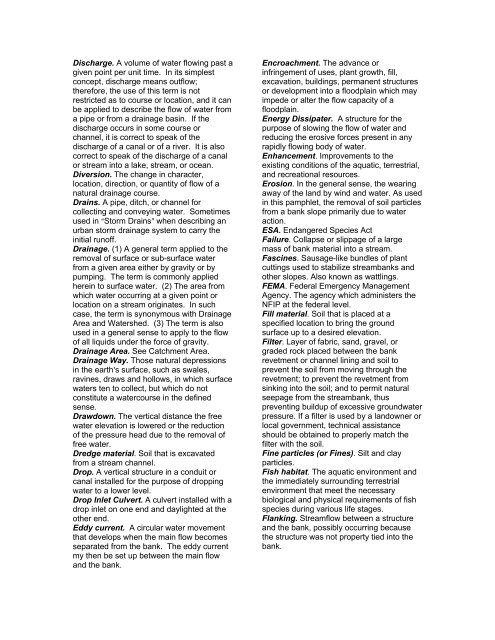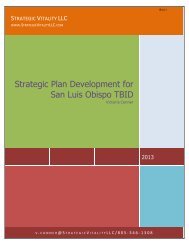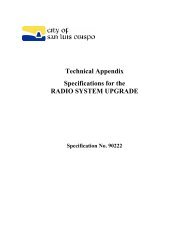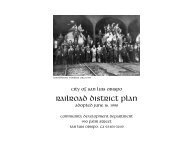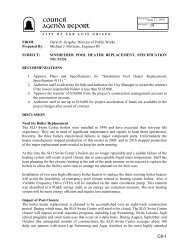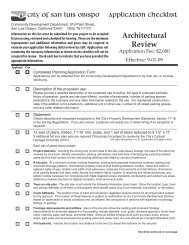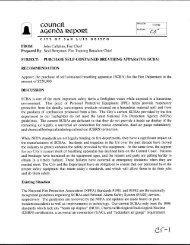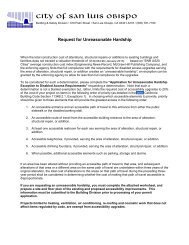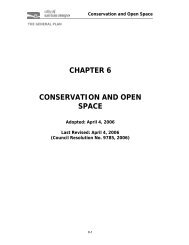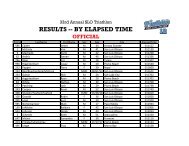Drainage Design Manual - the City of San Luis Obispo
Drainage Design Manual - the City of San Luis Obispo
Drainage Design Manual - the City of San Luis Obispo
You also want an ePaper? Increase the reach of your titles
YUMPU automatically turns print PDFs into web optimized ePapers that Google loves.
Discharge. A volume <strong>of</strong> water flowing past agiven point per unit time. In its simplestconcept, discharge means outflow;<strong>the</strong>refore, <strong>the</strong> use <strong>of</strong> this term is notrestricted as to course or location, and it canbe applied to describe <strong>the</strong> flow <strong>of</strong> water froma pipe or from a drainage basin. If <strong>the</strong>discharge occurs in some course orchannel, it is correct to speak <strong>of</strong> <strong>the</strong>discharge <strong>of</strong> a canal or <strong>of</strong> a river. It is alsocorrect to speak <strong>of</strong> <strong>the</strong> discharge <strong>of</strong> a canalor stream into a lake, stream, or ocean.Diversion. The change in character,location, direction, or quantity <strong>of</strong> flow <strong>of</strong> anatural drainage course.Drains. A pipe, ditch, or channel forcollecting and conveying water. Sometimesused in AStorm Drains@ when describing anurban storm drainage system to carry <strong>the</strong>initial run<strong>of</strong>f.<strong>Drainage</strong>. (1) A general term applied to <strong>the</strong>removal <strong>of</strong> surface or sub-surface waterfrom a given area ei<strong>the</strong>r by gravity or bypumping. The term is commonly appliedherein to surface water. (2) The area fromwhich water occurring at a given point orlocation on a stream originates. In suchcase, <strong>the</strong> term is synonymous with <strong>Drainage</strong>Area and Watershed. (3) The term is alsoused in a general sense to apply to <strong>the</strong> flow<strong>of</strong> all liquids under <strong>the</strong> force <strong>of</strong> gravity.<strong>Drainage</strong> Area. See Catchment Area.<strong>Drainage</strong> Way. Those natural depressionsin <strong>the</strong> earth=s surface, such as swales,ravines, draws and hollows, in which surfacewaters ten to collect, but which do notconstitute a watercourse in <strong>the</strong> definedsense.Drawdown. The vertical distance <strong>the</strong> freewater elevation is lowered or <strong>the</strong> reduction<strong>of</strong> <strong>the</strong> pressure head due to <strong>the</strong> removal <strong>of</strong>free water.Dredge material. Soil that is excavatedfrom a stream channel.Drop. A vertical structure in a conduit orcanal installed for <strong>the</strong> purpose <strong>of</strong> droppingwater to a lower level.Drop Inlet Culvert. A culvert installed with adrop inlet on one end and daylighted at <strong>the</strong>o<strong>the</strong>r end.Eddy current. A circular water movementthat develops when <strong>the</strong> main flow becomesseparated from <strong>the</strong> bank. The eddy currentmy <strong>the</strong>n be set up between <strong>the</strong> main flowand <strong>the</strong> bank.Encroachment. The advance orinfringement <strong>of</strong> uses, plant growth, fill,excavation, buildings, permanent structuresor development into a floodplain which mayimpede or alter <strong>the</strong> flow capacity <strong>of</strong> afloodplain.Energy Dissipater. A structure for <strong>the</strong>purpose <strong>of</strong> slowing <strong>the</strong> flow <strong>of</strong> water andreducing <strong>the</strong> erosive forces present in anyrapidly flowing body <strong>of</strong> water.Enhancement. Improvements to <strong>the</strong>existing conditions <strong>of</strong> <strong>the</strong> aquatic, terrestrial,and recreational resources.Erosion. In <strong>the</strong> general sense, <strong>the</strong> wearingaway <strong>of</strong> <strong>the</strong> land by wind and water. As usedin this pamphlet, <strong>the</strong> removal <strong>of</strong> soil particlesfrom a bank slope primarily due to wateraction.ESA. Endangered Species ActFailure. Collapse or slippage <strong>of</strong> a largemass <strong>of</strong> bank material into a stream.Fascines. Sausage-like bundles <strong>of</strong> plantcuttings used to stabilize streambanks ando<strong>the</strong>r slopes. Also known as wattlings.FEMA. Federal Emergency ManagementAgency. The agency which administers <strong>the</strong>NFIP at <strong>the</strong> federal level.Fill material. Soil that is placed at aspecified location to bring <strong>the</strong> groundsurface up to a desired elevation.Filter. Layer <strong>of</strong> fabric, sand, gravel, orgraded rock placed between <strong>the</strong> bankrevetment or channel lining and soil toprevent <strong>the</strong> soil from moving through <strong>the</strong>revetment; to prevent <strong>the</strong> revetment fromsinking into <strong>the</strong> soil; and to permit naturalseepage from <strong>the</strong> streambank, thuspreventing buildup <strong>of</strong> excessive groundwaterpressure. If a filter is used by a landowner orlocal government, technical assistanceshould be obtained to properly match <strong>the</strong>filter with <strong>the</strong> soil.Fine particles (or Fines). Silt and clayparticles.Fish habitat. The aquatic environment and<strong>the</strong> immediately surrounding terrestrialenvironment that meet <strong>the</strong> necessarybiological and physical requirements <strong>of</strong> fishspecies during various life stages.Flanking. Streamflow between a structureand <strong>the</strong> bank, possibly occurring because<strong>the</strong> structure was not property tied into <strong>the</strong>bank.


